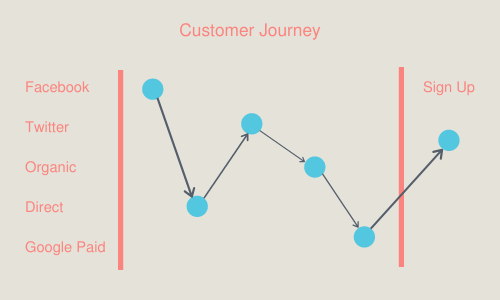How do you drive profitable growth if you’re not sure where to allocate your marketing dollars? In today’s increasingly fragmented world—where buyer journeys span multiple devices, channels, and touchpoints before resulting in a conversion—this question remains more important than ever.
The answer is algorithmic attribution.
With the accelerated growth of new digital channels and technology, consumers have grown savvier (with shorter and shorter attention spans). According to a Cisco study, it takes a customer an average of 56 touchpoints to make a purchase. For marketers looking to get a full picture of performance, now is the time to make the move toward more comprehensive forms of marketing measurement.
What is an algorithmic multi-touch attribution (MTA) model?
Single-touch attribution has been the mainstay model for several years; its ease of use and popularity stems from its ties to Google Analytics. However, a single-touch attribution model gives 100% of conversion credit to just one touchpoint without being able to evaluate the impact of each individual touchpoint (and the actions the user took during that session) leading up to a conversion. Below are some examples of single-touch attribution models:
- Last touch: gives 100% of the credit to the last marketing touchpoint before conversion
- Last click: gives 100% of the credit to the “last click” before conversion
- First touch: gives 100% of the credit to the first marketing touchpoint (the channel or activity that acquired the customer)
- First click: gives 100% of the credit to the “first click”
In short, it simply doesn’t make sense to blindly assign credit to a single conversion touchpoint without rhyme or reason. You’re likely already investing your ad dollars in different channels and campaigns—so why not be that forward-thinking marketer and start assigning credit, based on data, to every user action on the basis of their true contribution to conversion?
Algorithmic MTA models are the new best practice for assigning the most accurate, relevant credit to customer touchpoints possible by broadening marketers’ understanding of how different channel interactions are directly impacting marketing performance. Here’s an example of what that a typical customer journey might look like:

By optimally measuring the performance of every touchpoint (and user actions during those touchpoints)—algorithmic MTA has been proven to be far more superior compared to first-touch or last-touch models.
Going deeper, algorithmic attribution looks for differences in the ways customers who convert engage with marketing versus those who don’t convert—allowing marketers to objectively gamify credit to those higher-conversion engagements. Essentially, it looks for patterns between profitable audiences as opposed to unprofitable audiences. When it finds consistent patterns in the sequence of people who do convert, it focuses more on those patterns.
Key considerations in choosing an attribution model that works for your core business
Google Ads and Google Analytics currently use a data-driven approach (DDA) to multi-touch attribution, which gives credit for conversions based on how people engage with your various ads and decide to become your customers. But you should not only consider using a DDA or a third-party MTA model, you should take a step further and add “soft conversions” as touchpoints that feed into your platforms. A common soft conversion would be a customer adding to cart, showing a demonstrable interest in your product or services. While many marketers already track that event in Google Analytics to assist with remarketing, one could dig deeper by assigning cart abandon as a goal in the platform to track where they’re losing customers. Here is an example of a visitor interacting with several soft conversions before ultimately making a purchase:
Spent 30 seconds on site→ visited 3+ product detail pages→ looked at reviews for products on page→ added to cart→ began checkout→ purchase
Instead of assigning 100% of value to the final touchpoint (purchase), marketers must pivot to an algorithmic MTA model that takes other soft conversions that existed in that converting pathway into account. Certain metrics and characteristics that are essential to the algorithm’s core include:
- Considering all active marketing channels
- The nature of the touchpoint (e.g. click, download, sign-up)
- The level of on-site user engagement (e.g. time spent on page)
- Adapting when the media mix evolves
By taking this more holistic view of your customers, you can feed this data into both your automated and manual bidding techniques and optimize campaigns accordingly. The combination of sharing credit through MTA as well as assigning values to soft conversions through algorithmic attribution can lead to the ultimate gamification of performance marketing.
Using an algorithmic MTA model to maximize return on marketing investment
While the shortcut is to simply use Google Analytics for free and operate off of their last-click model to determine where conversions are coming from—that’s simply not a true reflection of today’s customer journey.
An algorithmic MTA model allows you to identify more than just the channels that are performing well at any given touchpoint. The true power of this approach is its ability to help marketers understand how their channels work hand-in-hand to move customers along the funnel to an eventual conversion. Other advantages include:
- Unified measurement: Better insights into marketing efforts for a holistic, integrated view of customer engagements
- Real-time optimization: A granular understanding of what’s working to reach the right audience at the right time with the right message
- Smarter investments: Powerful marketing intel to make smarter spending decisions and reap a higher return on investment (ROI)
Simply put: it helps marketers figure out what’s working and what isn’t—and devote funds to the channels that provide the highest ROI. If any of the following apply to your business, you should be using qualified algorithmic MTA:
- You’re marketing through multiple channels and networks: Algorithmic attribution won’t be of much-added value unless you’re marketing through multiple ad platforms. At this point, your customers’ path to purchase isn’t as straightforward, meaning you need a more sophisticated way of informing budget allocation across ad platforms.
- You’re considering or actively buying offline channels: The moment you engage in offline marketing such as print media, trade shows, etc., is the moment Google Analytics becomes inadequate for feeding relevant data. If you can’t measure your offline marketing, you have no way of knowing where to increase or cut back spending.
- Your team has set realistic goals and expectations: The benefits of an algorithmic model are rarely realized overnight. All of the teams involved should understand that you’re building the necessary marketing foundation for the next couple of years, not tomorrow. It’s likely that for the first few months, your campaigns will be running without any algorithmic optimizations in order to establish a baseline performance benchmark.
- You need to show how your marketing is producing results: In an ideal world, it would be nice to funnel marketing dollars into every channel possible. But, in reality, marketers have a limited budget and need to maximize ROI across the board. The solution: an algorithmic attribution strategy makes it possible for marketing teams to optimize their campaigns in order to bring in more revenue for every dollar spent and cut off any tactics that are under-performing.
How to choose the right attribution software that fits your needs
The next step is to search for marketing attribution software that’ll enable you to measure more than just clicks, gather conversions from individual platforms, and integrate them to get accurate overall conversion-data. Here are some tips to get started:
- Consider software tools that manage and track complicated MTA models, such as an analytics dashboard or a reporting mechanism that offers both high-level and granular details about the performance of each channel and touchpoint
- Look for solutions that offer the ability to see how customers behave and interact with your brand across multiple channels. Having a centralized dashboard provides the accurate insight needed for cross-channel analysis.
- Most importantly, ensure that the system pipes the data back into the platforms. While a sophisticated MTA model might help humans better understand what is working and what isn’t, we need to also inform the automated bidding that happens during the auction in order to truly unlock the benefits of MTA.
Remember that data by itself is inherently useless; driving to actionable insights is the ultimate goal for any business.
Apply and deepen customer insights through continuous optimization
Algorithmic MTA isn’t a set-it-and-forget-it event. In order to unleash its full potential, it’s critical to continuously test, analyze, and further optimize your model to inform your marketing efforts and ensure you reach the right customers at the right time.
For instance, identifying and tracking soft conversions like cart abandonment can lead to crucial insights—and be the first step to continuous optimization.
The real purpose of an algorithmic attribution strategy is to help marketers invest in the experiences that are proven to drive growth. While the reality is that most marketers tend to have an incomplete (or even false) understanding of what motivates their consumers, this approach can help them understand to a much greater degree of certainty what role certain marketing tactics have on their broader audience segments.
Successful marketers are constantly deepening their insights and leveraging data to test performance. A performance marketing framework built on a strong foundation of key learnings—and fueled by the continuous interaction of data and strategy—will do wonders for your marketing, customer relationships, and bottom line.







Responses